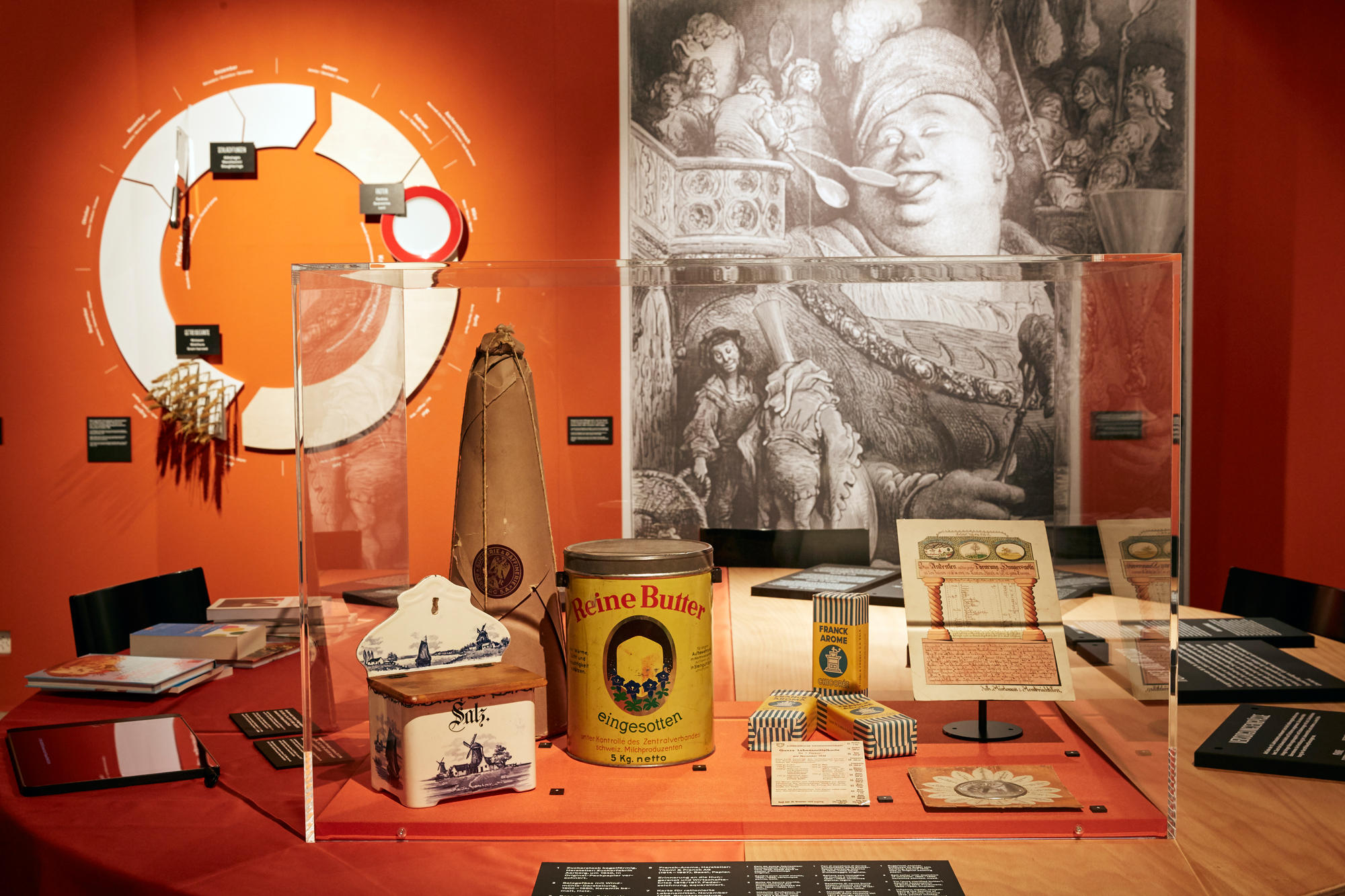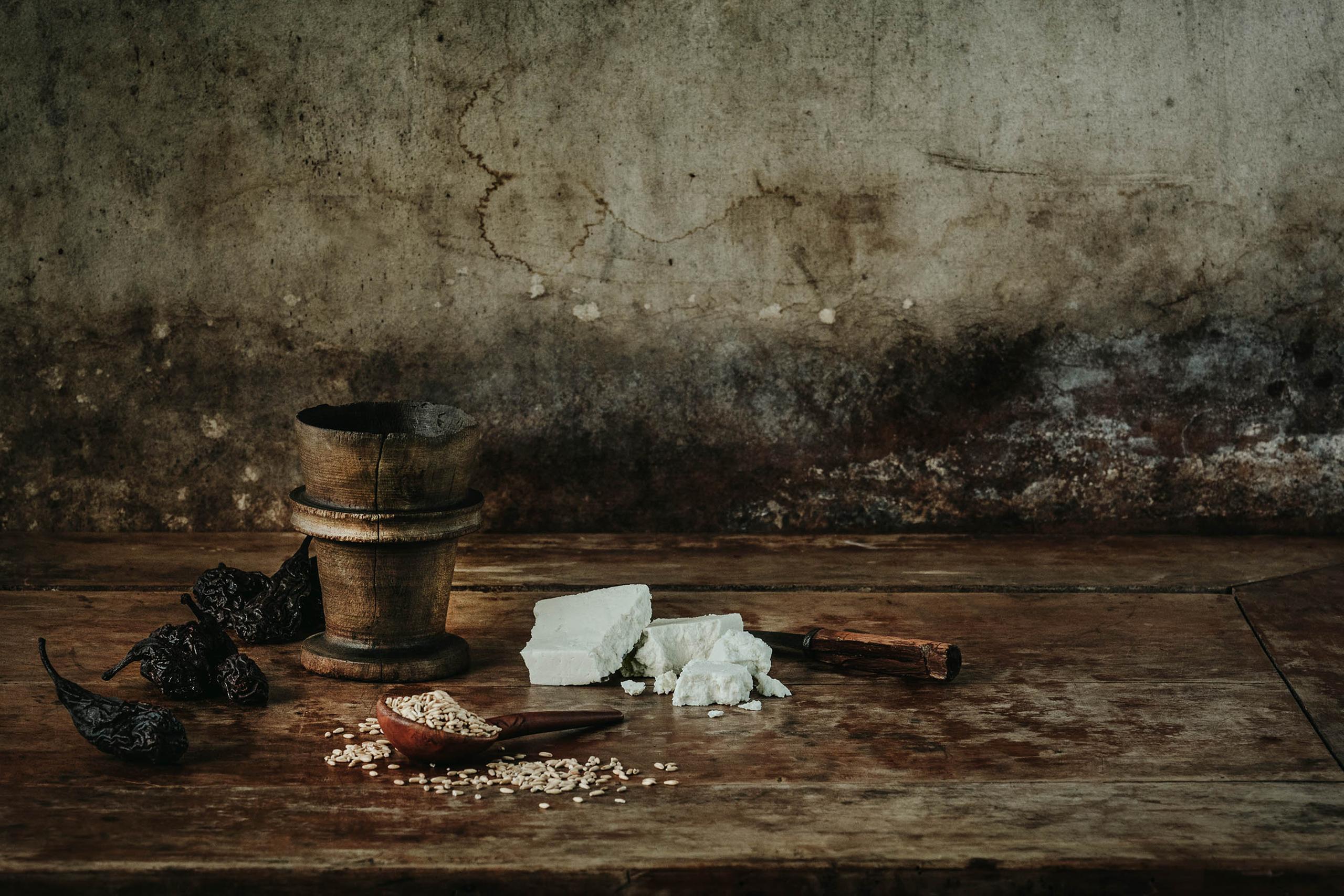
What do the Swiss eat?

There is no such thing as a Swiss national cuisine. Instead, each region produces its own unique specialities. A new exhibition lifts the lid on the key ingredients that make up Switzerland’s culinary heritage.
“Eating is a fascinating subject that is much bigger than the simple need to consume food,” explains curator Pia Schubiger as she starts her guided tour of the “What does Switzerland eat?”External link exhibition at the Swiss National Museum in Schwyz.
In each room, the centrepiece is a table, presenting a unique aspect of Switzerland’s dining culture.
“The table is where we meet and where we socialise while we eat,” she declares.
The Schwyz exhibition sheds light on various aspects of Swiss culinary habits and table manners from over the years. We learn, for example, that linen tablecloths and napkins started to be used more widely in Switzerland during the 15th century. And it was only in the 17th century that people started using a fork – a two-pronged utensil at the time – at the dinner table. Before, meals were eaten using a knife and a spoon.
“One of the exhibition highlights is the Einsiedeln tableware service,” adds Schubiger, pointing to an 18th-century dinner, tea and coffee service. The Zurich government gave the 300-piece porcelain set as a gift to Einsiedeln Abbey in canton Schwyz in 1776 to thank it for mediating in a dispute. It was manufactured in Switzerland’s first porcelain factory in Kilchberg-Schooren.
But what kinds of food did people actually serve up at that time? Farming and social standing were always the two main factors influencing what appeared on people’s plates, right up until the industrial era in the 19th century and the democratisation of food in the 20th century.
The exhibition features a series of menus from the 15th to 21st centuries that resemble Baroque still-life paintings.
“The pictures are meant to whet your appetite,” explains Schubiger. They also have menus of the future, with an insect kebab or laboratory-grown meat and micro leaves.

More
Swiss National Museum exhibition
A new law has just come into force in Switzerland that legalises the consumption of insects such as crickets, mealworms and locusts. The eating of meat and its environmental impact, and the related question of factory farming, have become hot political topics. The exhibition devotes an entire section to these issues.
The meat section even has its own butcher’s – full of knitted salamis, joints of meat and even a pig’s head. They are the creation of Madame Tricot, an artist who specialises in knitting.
“She knits everything she eats,” explains Schubiger.
The Swiss have been big meat-eaters ever since the 19th century when consumption started to rise, largely driven by the meat industry. Consumption increased from 31.5kg per person in 1950 to a peak of 71kg per capita in 1987. Although each Swiss citizen now eats an average of 52kg of meat annually, global consumption continues to rise, with experts predicting figures to double by 2050.
In this regard, the exhibition serves up some alternative ideas and statistics. Many people are slightly wary, but what would happen if we consumed less meat and ate insects instead? Two billion people around the world already consume insects on a regular basis. The greenhouse gases produced by insect farming are a hundred times lower than those of cattle farming. In addition, the amount of animal feed required to produce one kilogram of beef can yield twelve times as much insect meat.
Marketing campaign
“Eating is an everyday affair – but it’s not mundane,” declared Schubiger at the start of her museum tour. This is very clear as we pass from room to room.
In one section, a half-empty table highlights the fact that the Swiss have also lived through several famines. Yet the second half of the 20th century was characterised by an abundance of food.
In 1984, the Swiss Nutrition Report revealed that the Swiss were overeating – too much sugar and fat and too little fibre. Today, as a result half of Swiss men and one third of Swiss women are overweight. “What we eat also depends on what the food industry wants to sell us,” says Schubiger.
Visitors can also learn more about fondue, the quintessential Swiss meal, which was actually chosen as Switzerland’s national dish in 1930 following a clever marketing campaign by the Swiss Cheese Union.
Fondue is said to have been invented by alpine herdsmen and dairymen, with the first recipe dating back to 1699. However, there is nothing in the recipe about “fondue” or cubes of bread on a skewer. Nowadays, the cheesy soup is eaten throughout Switzerland, although each region makes it according to a slightly different recipe.
As our tour draws to a close, Schubiger invites us to tuck into some of the products on display on a final table.
“After all, eating is also a feast for the senses,” she says with a smile.
Homemade amaretto and chocolate truffles are laid out on the green tablecloth alongside beautifully presented small bowls of insects. Bon appétit!

In compliance with the JTI standards
More: SWI swissinfo.ch certified by the Journalism Trust Initiative
































You can find an overview of ongoing debates with our journalists here . Please join us!
If you want to start a conversation about a topic raised in this article or want to report factual errors, email us at english@swissinfo.ch.